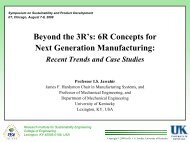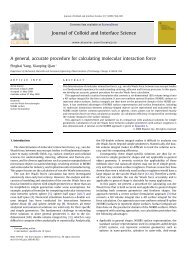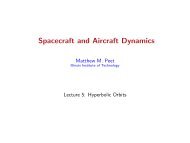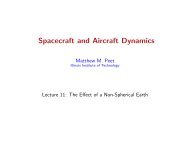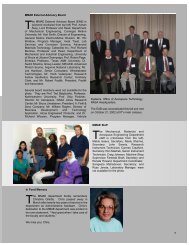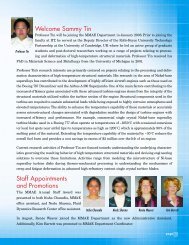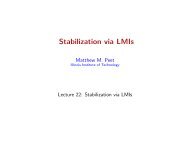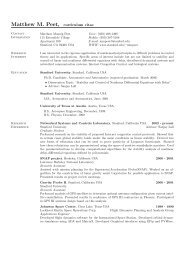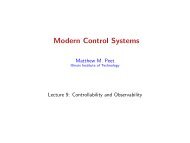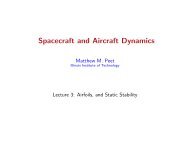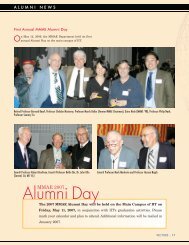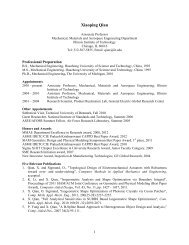1264X. Qian, D. Dutta / Computer-Aided Design 36 (2004) 1263–1278Fig. 1. Schematic structure of an FGM interface within a prosthesis.hydroxyapatite (HAp). Ti has good mechanical toughnessand HAp has good biocompatibility. Simple combination ofTi and HAp would cause bio-incompatibility and weakenedstrength due to their material property differences. Suchmaterial property differences are resolved in <strong>heterogeneous</strong><strong>objects</strong> by using a mixture of Ti and HAp with varyingproportions. The sharp interface between the Ti and HAp iseliminated due to a graded zone of Ti/HAp. The bendingstrength of the resulting material is similar to a human bone.As evidenced in this example, many applications <strong>based</strong>on the concept of functionally gradient materials can bedeveloped to exploit multiple desirable material propertiesfrom different materials. In order to obtain mass applicationsof such <strong>heterogeneous</strong> <strong>objects</strong>, efficient and effective<strong>design</strong> methodologies <strong>for</strong> <strong>heterogeneous</strong> <strong>objects</strong> are crucial.Existing <strong>design</strong> methodologies are highly sophisticated, butthey are inefficient and even infeasible <strong>for</strong> handling<strong>heterogeneous</strong> <strong>objects</strong>. These methodologies are primarilydeveloped <strong>for</strong> the production of homogeneous <strong>objects</strong> ofwhich there is only one homogeneous material. Theintroduction of material variation throughout the <strong>objects</strong>adds a new dimension to the problem.The state-of-the-art research on <strong>heterogeneous</strong> objectmodeling has been primarily focusing on representationschemes <strong>for</strong> <strong>heterogeneous</strong> <strong>objects</strong>. Currently, there is onlylimited means available to obtain <strong>heterogeneous</strong> objectmodel. They are ineffective <strong>for</strong> <strong>heterogeneous</strong> object <strong>design</strong>in that these <strong>heterogeneous</strong> object models do not explicitlycapture <strong>design</strong> intent and they do not support iterative<strong>design</strong> processes.To address these issues, in this research we propose theuse of features to facilitate the <strong>design</strong> of heteorgeneous<strong>objects</strong>. In the example of the prosthesis <strong>design</strong>, the choicesof materials (Ti and HAp) and the graded interface are <strong>based</strong>on a <strong>design</strong>er’s experience and these choices have specificphysical reasons. Ti has good mechanical strength. HAp is astrorage <strong>for</strong>m of Calcium and Phosporus in the bone and ithas good bio-compatibility. We provide a <strong>design</strong> tool thatallows <strong>design</strong>ers to <strong>design</strong> such <strong>heterogeneous</strong> <strong>objects</strong> witha high level <strong>design</strong> component—features. Under thisframework, a <strong>design</strong>er can incorporate the <strong>design</strong> intuitioninto the <strong>design</strong> process. Instead of specifying materialcomposition <strong>for</strong> each spatial location within the object, theusers can choose a feature (a graded interface in thisexample) and the desired material properties at the desiredlocations when <strong>design</strong>ing the object.The remainder of this paper is organized as follows. InSection 2, we present a review of the existing researchrelating to the <strong>design</strong> of <strong>heterogeneous</strong> <strong>objects</strong>. In Section 3,a general methodology—feature <strong>based</strong> <strong>design</strong> (FBD) <strong>for</strong><strong>heterogeneous</strong> <strong>objects</strong>—is presented. Sections 4 and 5present two enabling component techniques <strong>for</strong> a feature<strong>based</strong> <strong>design</strong> method, material heterogeneity modelingwithin each material feature and constructive featureoperations <strong>for</strong> combining material features. Section 6presents the implementation and examples of the feature<strong>based</strong> <strong>design</strong> methodology, including the feature <strong>based</strong><strong>design</strong> process <strong>for</strong> the prosthesis <strong>design</strong>. Finally, Section 7summarizes this paper.2. Literature reviewMany representation schemes have been developed torepresent solids. Manifold solids and R-sets were firstproposed to represent solid model [8,25]. Radial-edge datastructure is another data structure <strong>for</strong> modeling nonmanifoldsolid [32]. For conventional feature modeling,the usage of non-manifold structure was first proposed byPratt [19]. Selected Geometric Complex (SGC) is a nonregularizednon-homogeneous point set represented throughenumeration as union of mutually disjoint connected opencells [26]. Constructive Non-Regularized Geometry(CNRG) was also proposed to support dimensionallynon-homogeneous, non-closed point sets with internalstructures [27]. Middleditch et al. presented mathematics
X. Qian, D. Dutta / Computer-Aided Design 36 (2004) 1263–1278 1265and <strong>for</strong>mal specification <strong>for</strong> the mixed dimensional cellulargeometric modeling [16].Current research on <strong>heterogeneous</strong> <strong>objects</strong> has led tomany representation schemes <strong>for</strong> <strong>heterogeneous</strong> objectmodeling. Kumar and Dutta proposed R-m sets be used<strong>for</strong> representing <strong>heterogeneous</strong> <strong>objects</strong> [12]. Jackson et al.proposed another modeling approach <strong>based</strong> on subdividingthe solid model into sub-regions and associating theanalytical composition blending function with each region[10,11]. Park et al. presented a volumetric texturingapproach <strong>for</strong> modeling <strong>heterogeneous</strong> <strong>objects</strong> [17]. Biswaset al. proposed a distance field <strong>based</strong> approach <strong>for</strong><strong>heterogeneous</strong> object modeling, in which the space isparametrized by distance to the geometry boundaries [4].Huang and Fadel employed a Bezier basis function <strong>for</strong>optimizing material heterogeneity in flywheel [9]. Dutta[29] and Tan [30] presented constructive approaches <strong>for</strong><strong>heterogeneous</strong> object modeling. Kumar and Dutta presenteda trivial fiber-bundle <strong>based</strong> model to represent severalattributes of an object along with the geometry [13]. Paskoet al. used a functional representation (Frep) to constructivelymodel object geometry and properties of arbitrarynature [18].Even though existing representation schemes <strong>for</strong> <strong>heterogeneous</strong><strong>objects</strong> provide means to represent <strong>heterogeneous</strong><strong>objects</strong>, they do not necessarily support the <strong>heterogeneous</strong>object <strong>design</strong> process. The current methods <strong>for</strong> specifyingmaterial composition face a trade-off between the modelcoverage and operation convenience [23]. These methodsonly provide a low level description of geometry andmaterial composition within the <strong>objects</strong>. The characteristicsof material variation are not explicitly captured. Theresulting material properties are often not available <strong>for</strong><strong>design</strong>ers. These methods do not provide effective tools <strong>for</strong><strong>design</strong>ers to create and edit the <strong>heterogeneous</strong> object model.In the domain of homogeneous <strong>objects</strong>, featuremethodologies have been extensively researched to facilitatetheir <strong>design</strong> and fabrication. <strong>Feature</strong>s were initiallyproposed to automate the link between <strong>design</strong> and NC pathgeneration [7]. Since then, feature techniques have beenwidely and successfully used in CAD/CAM systems.<strong>Feature</strong>-<strong>based</strong> <strong>design</strong> expedites the <strong>design</strong> process andfeature recognition facilitates the fabrication processplanning. A feature-<strong>based</strong> product model also simplifiesthe assembly, inspection planning, and other downstreamapplications [28].In order to facilitate the <strong>design</strong> and fabrication of<strong>heterogeneous</strong> <strong>objects</strong>, Qian and Dutta proposed the usageof feature methodologies <strong>for</strong> the <strong>design</strong> and layeredmanufacturing of <strong>heterogeneous</strong> <strong>objects</strong> [20,21]. Thispaper will present some of the results. Liu et al. alsopresented their feature <strong>based</strong> <strong>design</strong> approach to achievelocal control of material properties, in which they usedthe Laplace equation to create material compositionblending [14].3. <strong>Feature</strong> <strong>based</strong> <strong>design</strong> <strong>for</strong> <strong>heterogeneous</strong> <strong>objects</strong>In this section, we examine the relationships between<strong>for</strong>m features and material features in <strong>heterogeneous</strong><strong>objects</strong>. We synthesize <strong>for</strong>m features and material featuresand we propose a constructive feature <strong>based</strong> <strong>design</strong> method<strong>for</strong> <strong>heterogeneous</strong> <strong>objects</strong>.3.1. <strong>Feature</strong>s<strong>Feature</strong> techniques, traditionally, have only been focusingon the geometry, i.e. <strong>for</strong>m features. Because of thenature of material variation in <strong>heterogeneous</strong> <strong>objects</strong>, weshall examine features not only in terms of the geometry butalso in terms of the material composition in a part.In order to mathematically represent the features, we firstdefine some notations. A part, PðG; MÞ; is defined as aproduct space, where G is the geometry and M is thematerial space.3.1.1. Form featureForm feature is a specific geometric shape, which carriesengineering significance, such as a hole and a slot. A <strong>for</strong>mfeature can be either a volume feature or a surface feature. Inthis paper, we focus on volume features.As with homogeneous <strong>objects</strong>, a <strong>for</strong>m feature in<strong>heterogeneous</strong> <strong>objects</strong> is a specific shape within a partregardless of the material composition variation. In order todistinguish <strong>for</strong>m features from material features, we notetwo necessary conditions to the definitions of <strong>for</strong>m features.First, the shape of the volume must correspond to somespecific engineering meaning. For example, <strong>for</strong>m featuressuch as a hole or a groove, have specific geometric shapesand engineering significance. Second, such a shape shouldcontribute to the <strong>for</strong>mation of the boundary of the final partgeometry. That is to say, during the part creation process,the evolving part geometries should be different be<strong>for</strong>e andafter the introduction of the <strong>for</strong>m features. We note the partgeometry as G i be<strong>for</strong>e the <strong>for</strong>m feature FF iþ1 is introducedto the part. Then the second necessary condition <strong>for</strong> <strong>for</strong>mfeatures can be represented as: FF iþ1 2 G i – B: This willbe further explained in Section 3.1.3.For example, in Fig. 2, the <strong>heterogeneous</strong> object hasthree <strong>for</strong>m features: a block, a hole, and a boss. They eachrepresent a particular geometric shape. If we disregard thematerial variation in the object, these three <strong>for</strong>m featurescreate the final geometry of the object. In the two FGMregions, FGM1 is a <strong>for</strong>m feature while FGM2 is not. FGM2does not satisfy the second condition of <strong>for</strong>m feature, i.e.FGM2, as a shape, does not contribute to the boundary offinal part geometry.3.1.2. Material featureBe<strong>for</strong>e we present the definition of material features, wefirst examine material variation in <strong>heterogeneous</strong> <strong>objects</strong>.




